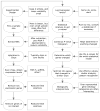Statistics and bioinformatics in nutritional sciences: analysis of complex data in the era of systems biology
- PMID: 20233650
- PMCID: PMC2885517
- DOI: 10.1016/j.jnutbio.2009.11.007
Statistics and bioinformatics in nutritional sciences: analysis of complex data in the era of systems biology
Abstract
Over the past 2 decades, there have been revolutionary developments in life science technologies characterized by high throughput, high efficiency, and rapid computation. Nutritionists now have the advanced methodologies for the analysis of DNA, RNA, protein, low-molecular-weight metabolites, as well as access to bioinformatics databases. Statistics, which can be defined as the process of making scientific inferences from data that contain variability, has historically played an integral role in advancing nutritional sciences. Currently, in the era of systems biology, statistics has become an increasingly important tool to quantitatively analyze information about biological macromolecules. This article describes general terms used in statistical analysis of large, complex experimental data. These terms include experimental design, power analysis, sample size calculation, and experimental errors (Type I and II errors) for nutritional studies at population, tissue, cellular, and molecular levels. In addition, we highlighted various sources of experimental variations in studies involving microarray gene expression, real-time polymerase chain reaction, proteomics, and other bioinformatics technologies. Moreover, we provided guidelines for nutritionists and other biomedical scientists to plan and conduct studies and to analyze the complex data. Appropriate statistical analyses are expected to make an important contribution to solving major nutrition-associated problems in humans and animals (including obesity, diabetes, cardiovascular disease, cancer, ageing, and intrauterine growth retardation).
(c) 2010 Elsevier Inc. All rights reserved.
Figures



Similar articles
-
Folic acid supplementation and malaria susceptibility and severity among people taking antifolate antimalarial drugs in endemic areas.Cochrane Database Syst Rev. 2022 Feb 1;2(2022):CD014217. doi: 10.1002/14651858.CD014217. Cochrane Database Syst Rev. 2022. PMID: 36321557 Free PMC article.
-
Proteomics and systems biology: current and future applications in the nutritional sciences.Adv Nutr. 2011 Jul;2(4):355-64. doi: 10.3945/an.111.000554. Epub 2011 Jun 28. Adv Nutr. 2011. PMID: 22332076 Free PMC article. Review.
-
Investigating cholesterol metabolism and ageing using a systems biology approach.Proc Nutr Soc. 2017 Aug;76(3):378-391. doi: 10.1017/S0029665116002822. Epub 2016 Nov 2. Proc Nutr Soc. 2017. PMID: 27804896 Review.
-
Macromolecular crowding: chemistry and physics meet biology (Ascona, Switzerland, 10-14 June 2012).Phys Biol. 2013 Aug;10(4):040301. doi: 10.1088/1478-3975/10/4/040301. Epub 2013 Aug 2. Phys Biol. 2013. PMID: 23912807
-
ZBIT Bioinformatics Toolbox: A Web-Platform for Systems Biology and Expression Data Analysis.PLoS One. 2016 Feb 16;11(2):e0149263. doi: 10.1371/journal.pone.0149263. eCollection 2016. PLoS One. 2016. PMID: 26882475 Free PMC article.
Cited by
-
Proline and hydroxyproline metabolism: implications for animal and human nutrition.Amino Acids. 2011 Apr;40(4):1053-63. doi: 10.1007/s00726-010-0715-z. Epub 2010 Aug 10. Amino Acids. 2011. PMID: 20697752 Free PMC article. Review.
-
Protection against diabetic cardiomyopathy is achieved using a combination of sulforaphane and zinc in type 1 diabetic OVE26 mice.J Cell Mol Med. 2019 Sep;23(9):6319-6330. doi: 10.1111/jcmm.14520. Epub 2019 Jul 3. J Cell Mol Med. 2019. PMID: 31270951 Free PMC article.
-
Analysis of energy expenditure in diet-induced obese rats.Front Biosci (Landmark Ed). 2014 Jun 1;19(6):967-85. doi: 10.2741/4261. Front Biosci (Landmark Ed). 2014. PMID: 24896330 Free PMC article. Review.
-
Epigenetic influences in the aetiology of cancers arising from breast and prostate: a hypothesised transgenerational evolution in chromatin accessibility.ISRN Oncol. 2013;2013:624794. doi: 10.1155/2013/624794. Epub 2013 Feb 3. ISRN Oncol. 2013. PMID: 23431470 Free PMC article.
-
Metabolomic analysis of amino acid and energy metabolism in rats supplemented with chlorogenic acid.Amino Acids. 2014 Sep;46(9):2219-29. doi: 10.1007/s00726-014-1762-7. Epub 2014 Jun 14. Amino Acids. 2014. PMID: 24927697 Free PMC article.
References
-
- Hennig B, Oesterling E, Toborek M. Environmental toxicity, nutrition, and gene interactions in the development of atherosclerosis. Nutr Metab Cardiovas Dis. 2007;17:162–9. - PubMed
-
- Baker DH. Advances in protein-amino acid nutrition of poultry. Amino Acids. 2009;37:29–41. - PubMed
-
- Dekaney CM, Wu G, Yin YL, Jaeger LA. Regulation of ornithine aminotransferase gene expression and activity by all-trans retinoic acid in Caco-2 intestinal epithelial cells. J Nutr Biochem. 2008;19:674–81. - PubMed
-
- Mutch DM, Wahli W, Williamson G. Nutrigenomics and nutrigenetics: the emerging faces of nutrition. FASEB J. 2005;19:1602–16. - PubMed
Publication types
MeSH terms
Grants and funding
- P20 RR016481/RR/NCRR NIH HHS/United States
- U01 CA057030/CA/NCI NIH HHS/United States
- CA57030/CA/NCI NIH HHS/United States
- R01 CA057030/CA/NCI NIH HHS/United States
- P42 ES007380/ES/NIEHS NIH HHS/United States
- 1R21 HD049449/HD/NICHD NIH HHS/United States
- R21 HD049449/HD/NICHD NIH HHS/United States
- 2P42 ES007380-09/ES/NIEHS NIH HHS/United States
- P20 RR020145/RR/NCRR NIH HHS/United States
- P20RR020145-01/RR/NCRR NIH HHS/United States
- P20RR16481/RR/NCRR NIH HHS/United States
- R37 CA057030/CA/NCI NIH HHS/United States
LinkOut - more resources
Full Text Sources
Miscellaneous

